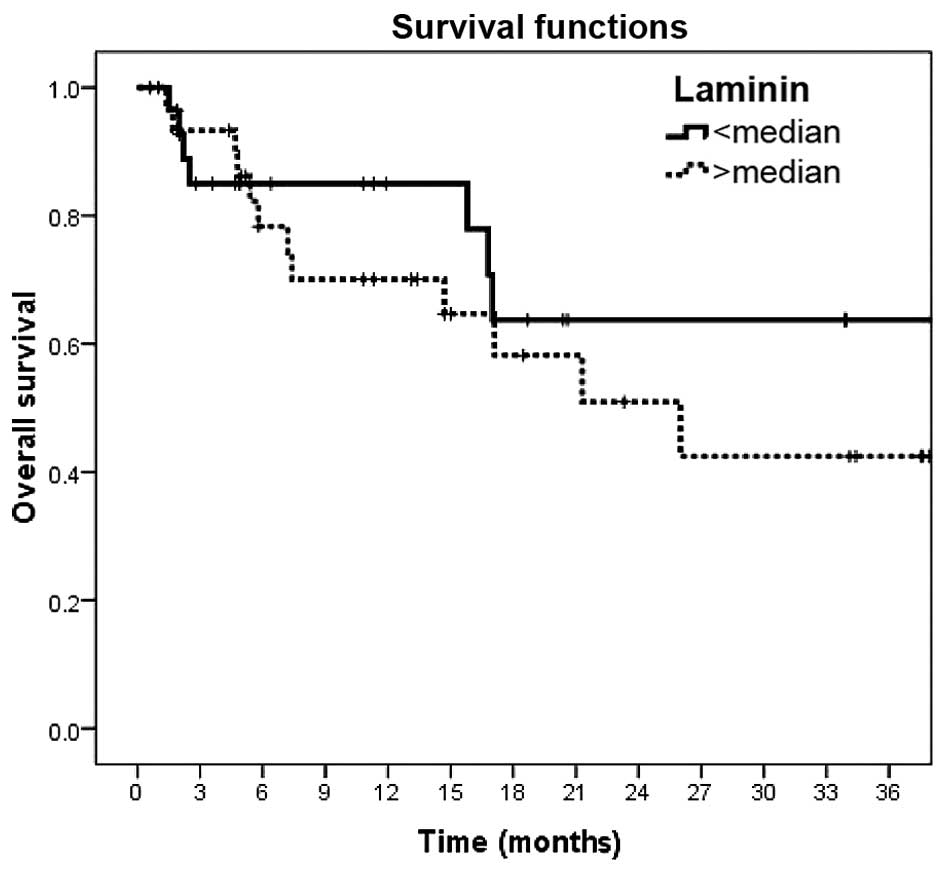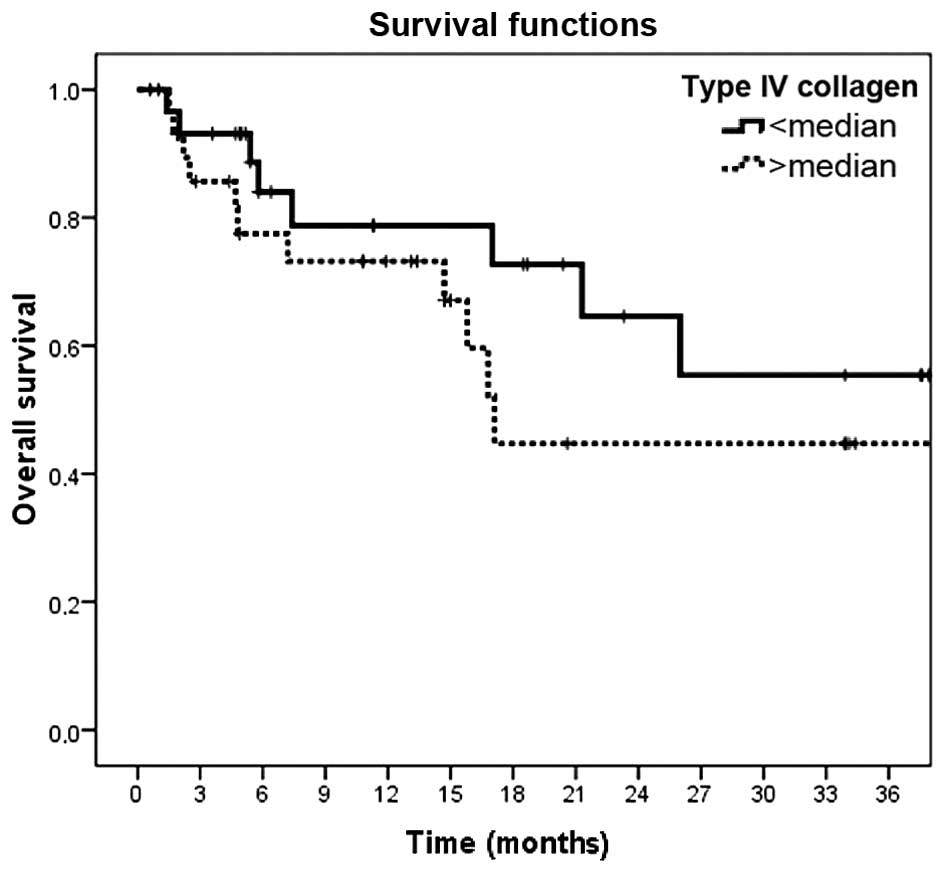Clinical significance of serum laminin and type‑IV collagen levels in cutaneous melanoma patients
- Authors:
- Published online on: April 25, 2016 https://doi.org/10.3892/mco.2016.873
- Pages: 195-200
Abstract
Introduction
Melanoma is a malignant tumor type which is highly invasive and of metastatic character. These features depend on alterations in the extracellular matrix (ECM) to modify cell adhesion, migration and invasion.
The proteins laminin and type-IV collagen are major structural constituents of the basement membrane, and serve as promoters of cell proliferation, differentiation, adhesion and migration via integrins and other cell surface receptors (1–11). Increased expression of laminin and type-IV (1–7) collagen (6,7,9–11) has also been demonstrated in melanoma cell lines with increased proliferation and metastatic potential (1–11).
While the function of the serum levels of laminin as biomarkers in patients with melanoma has been previously indicated (8), the majority of available data are from pre-clinical studies, and the concept remains to be further investigated and established in the clinical setting.
The present study investigated the concentration of circulating laminin and type-IV collagen in cutaneous melanoma patients and healthy controls and identified their association with patient prognosis, various clinical factors and responsiveness to chemotherapy in order to investigate whether their potential use as novel diagnostic or prognostic biomarkers.
Materials and methods
Patients
The cohort of the present study comprised 60 histologically confirmed cutaneous melanoma patients admitted to the Institute of Oncology (Istanbul University, Istanbul, Turkey). Patients with bi-dimensionally measurable disease without any history of chemotherapy or radiotherapy were included in the study. Staging was performed according to the staging system of the American Joint Committee on Cancer. The medical history of each patient was reviewed in detail; furthermore, physical examination and blood analyses were performed prior to the study. Patients with an Eastern Cooperative Oncology Group performance status of ≤2 and suitable blood parameters received various standard immunotherapy or chemotherapy schemes, including interferon alpha, cisplatin, dacarbazine or temozolomide, as well as novel agents, including ipilimumab and vemurafenib based on the stage of the disease. The revised Response Evaluation Criteria in Solid Tumours version 1.1 were used for assessing the patients' responsiveness to chemotherapy.
For comparison, 30 age- and gender-matched healthy subjects were included in the study. Informed consent was obtained from all patients and the study was reviewed and approved by the local Ethics Committee.
Measurement of serum laminin and type-IV collagen levels
Serum samples were drawn from patients and healthy controls by venipuncture and clotted at room temperature on first admission prior to treatment. The sera were collected after centrifugation and immediately frozen at −20°C until analysis.
Laminin ELISA (USCN Life Science Inc., Wuhan, China) and Collagen Type IV ELISA (USCN Life Science Inc.), double-antibody sandwich ELISA, were used for determination of the serum levels of laminin and type-IV collagen.
Statistical analysis
Values are expressed as median values and their ranges, standard deviation or standard error as indicated. Mann-Whitney U and Kruskal-Wallis tests were used to compare clinical and laboratory parameters to serum levels of laminin and type-IV collagen. The Kaplan-Meier test was used to estimate the survival and the differences in outcome were evaluated using the log-rank test. P≤0.05 was considered to indicate a significant difference between values. SPSS 16.0 software (SPSS Inc., Chicago, IL, USA) was used for all statistical analyses.
Results
Patient characteristics
A total of 60 cutaneous melanoma patients were enrolled in this study. Of these, 13 were classified as stage I–II, 14 as stage III and 31 as stage IV, while the stage remained elusive for 2 patients (Table I). The median age of the patients was 53.5 years (range, 16–88 years). Patient characteristics and pathological features are listed in Table I.
Comparison of serum laminin and type-IV collagen between melanoma patients and healthy controls
There was no statistically significant difference in the baseline serum levels of laminin between cutaneous melanoma patients and healthy controls (P=0.45) (Table II). However, the baseline serum levels of type-IV collagen of the melanoma patients were significantly elevated compared with those in the control group (P<0.001) (Table II). Clinical parameters, including patient age, gender, localization of lesion, histopathology, stage of disease and serum lactate dehydrogenase (LDH) concentration were found to not be linked with the serum levels of laminin, type-IV collagen or responsiveness to chemotherapy (P>0.05) (Table III).
Table II.Serum concentrations of laminin and type-IV collagen in melanoma patients and healthy controls determined by ELISA. |
Survival analysis
The median survival time of the patients was 26.0 months [95% confidence interval (CI): 21–30]. The one- and three-year overall survival rates were 76.3% (95% CI: 64–88) and 51.0% (95% CI: 33–69), respectively. Survival was significantly decreased for patients with distant metastasis (M1) (P<0.001), advanced metastatic disease (M1c) (P=0.007), anemia (P=0.05), elevated erythrocyte sedimentation rate (ESR) (P<0.001), elevated serum LDH concentration (P<0.001) and no responsiveness to chemotherapy (P=0.01) (Table IV). However, serum laminin and type-IV collagen levels were not found to be of prognostic value in melanoma patients (P=0.36 and P=0.26, respectively) (Table IV and Figs. 1 and 2).
Discussion
Laminin and type-IV collagen have been shown to be present at the dermoepidermal junction and in the dermis neighboring benign melanocytic nevi, dysplastic nevi, and in melanoma (7). While a consistent loss of laminin and type-IV collagen from the basement membrane zone has been observed in areas adjacent to junctional melanocytic proliferation, this decrease cannot sufficiently distinguish between benign junctional proliferation and invasive early melanoma. The type of staining in the surrounding area of deeper invasive cells and intradermal nevus cells was similar and suggested that melanocytic cells at these sites may actually synthesize laminin and type-IV collagen (7).
Laminin, a major structural component of the basement membrane, drives cell proliferation, differentiation, adhesion and migration via integrins and other cell surface receptors (1–8). Increased laminin expression was also observed in melanoma cell lines and led to increased melanoma cell proliferation and metastatic potential (1–7). Similar to laminin, type-IV collagen is also an important structural component of the ECM and promotes melanoma cell adhesion, migration and invasion (6,7,9–11). It has been proposed that type-IV collagen expression ensures the development of scaffolding required for angiogenesis in melanoma (6,7,9–11). Type-IV collagen is a ECM protein and is highly common within the basement lamina and intima underlining the endothelium, excited chemotaxis of a number of human melanoma cell lines by engaging α2β1 integrin in vitro. Certain signal transduction incidents are driven by type-IV collagen through β1 integrins, suggesting a significant role for NF-κB in arranging chemotaxis of melanoma (9).
The majority of the findings on the abovementioned ECM proteins have been obtained from pre-clinical tissue-cell investigations (1–7,9–11). Apart from the present study, laminin and type-VI collagen have been assessed in the sera of melanoma patients in only one other study by Burchardt et al (8), who examined the serum levels of laminin, type-VI collagen, hyaluronan and tenascin-C in the sera of 6 patients with stage-I/II cutaneous melanoma and 6 patients with metastatic disease via ELISA. In addition, four melanoma cell lines were also analyzed for the expression of these markers. No differences in laminin serum concentrations were observed between healthy individuals and stage I/II melanoma patients or between stage I/II melanoma patients and those with metastatic disease. However, compared to those in healthy controls, serum laminin levels were significantly elevated in metastatic patients (P=0.018). Furthermore, the serum levels of type-VI collagen in stage I/II (P=0.004) and IV melanoma patients (P=0.007) were elevated compared to those in healthy controls. No significant difference was detected between stage I/II and IV patients. The authors suggested that these ECM markers were involved in melanoma growth and extracellular matrix remodeling in the course of melanoma progression (8). These findings indicated that collagen type-VI and laminin may serve as novel serum markers for melanoma progression.
In the present study, a total of 60 patients various clinical stages of melanoma were enrolled. Similar to the study by Burchardt et al (8), the serum concentrations of these markers were quantitatively analyzed by solid-phase ELISA. In the present study, the baseline serum levels of type-IV collagen were significantly elevated in melanoma patients compared to those in the control group (P<0.001). However, no statistically significant difference in the baseline serum levels of laminin were detected between melanoma patients and healthy controls. Furthermore, clinical parameters, including patient age, gender, localization of lesion, histopathology, clinical stage of disease, serum LDH concentration and responsiveness to chemotherapy were found not to be associated with the serum levels of laminin and type-IV collagen. In addition, the serum levels of the two ECM proteins were shown to not be associated with patient survival and to therefore not to possess any prognostic value for melanoma patients.
In conclusion, the present study indicated that the serum levels of type-IV collagen may serve as a diagnostic biomarker in melanoma patients, while laminin levels were of no diagnostic value. However, the serum levels of neither of the two ECM proteins had any predictive or prognostic value in melanoma patients. The small size of the patient cohort and the short time to follow-up of the present study (36 months) represent significant limitations and may have affected the results. However, the present study contributed to the current understanding of the roles of these ECM proteins in the pathology of cutaneous melanoma in an anatolian or Asia minor population, and patients at various stages were included. Studies on larger patient populations are required to further determine the exact role of these biomarkers in cutaneous melanoma patients.
References
|
Chen HB, Chen L, Zhung JK, Chow VW, Wu BQ, Wang ZH, Cheng SB and Chew EC: Expression of laminin in metastatic melanoma cell lines with different metastatic potential. Anticancer Res. 21:505–508. 2001.PubMed/NCBI | |
|
Mortarini R, Gismondi A, Maggioni A, Santoni A, Herlyn M and Anichini A: Mitogenic activity of laminin on human melanoma and melanocytes: Different signal requirements and role of beta 1 integrins. Cancer Res. 55:4702–4710. 1995.PubMed/NCBI | |
|
Oikawa Y, Hansson J, Sasaki T, Rousselle P, Domogatskaya A, Rodin S, Tryggvason K and Patarroyo M: Melanoma cells produce multiple isoforms and strongly migrate on α5 laminin(s) via several integrin receptors. Exp Cell Res. 317:1119–1133. 2011. View Article : Google Scholar : PubMed/NCBI | |
|
Lugassy C, Torres-Muñoz JE, Kleinman HK, Ghanem G, Vernon S and Barnhill RL: Overexpression of malignancy-associated laminins and laminin receptors by angiotropic human melanoma cells in a chick chorioallontoic membrane model. J Cutan Pathol. 36:1237–1243. 2009. View Article : Google Scholar : PubMed/NCBI | |
|
Gradilone A, Gazzaniga P, Cigna E, et al: Fibronectin and laminin expression in sentinel lymph nodes of patients with malignant melanoma. Br J Dermatol. 157:398–401. 2007. View Article : Google Scholar : PubMed/NCBI | |
|
Ramos DM, Berston ED and Kramer RH: Analysis of integrin receptors for laminin and type IV collagen on metastatic B16 melanoma cells. Cancer Res. 50:728–734. 1990.PubMed/NCBI | |
|
Mackie RM, Clelland DB and Skerrow CJ: Type IV collagen and laminin staining patterns in benign and malignant cutaneous lesions. J Clin Pathol. 42:1173–1177. 1989. View Article : Google Scholar : PubMed/NCBI | |
|
Burchardt ER, Hein R and Bosserhoff AK: Laminin, hyaluronan, tenascin-C and type VI collagen levels in sera from patients with malignant melanoma. Clin Exp Dermatol. 28:515–520. 2003. View Article : Google Scholar : PubMed/NCBI | |
|
Hodgson L, Henderson AJ and Dong C: Melanoma cell migration to type IV collagen requires activation of NF-kappaB. Oncogene. 22:98–108. 2003. View Article : Google Scholar : PubMed/NCBI | |
|
Pasco S, Brassart B, Ramont L, et al: Control of melanoma cell invasion by type IV collagen. Cancer Detect Prev. 29:260–266. 2005. View Article : Google Scholar : PubMed/NCBI | |
|
Daniels KJ, Boldt HC, Martin JA, et al: Expression of type IV collagen in uveal melanoma: Its role in pattern formation and tumor progression. Lab Invest. 75:55–66. 1996.PubMed/NCBI |











